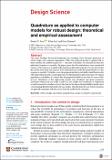Quadrature as applied to computer models for robust design: theoretical and empirical assessment
Author(s)
Frey, Daniel D; Lin, Yiben; Heijnen, Petra
DownloadPublished version (1.189Mb)
Publisher with Creative Commons License
Publisher with Creative Commons License
Creative Commons Attribution
Terms of use
Metadata
Show full item recordAbstract
<jats:title>Abstract</jats:title>
<jats:p>This paper develops theoretical foundations for extending Gauss–Hermite quadrature to robust design with computer experiments. When the proposed method is applied with <jats:italic>m</jats:italic> noise variables, the method requires 4<jats:italic>m</jats:italic> + 1 function evaluations. For situations in which the polynomial response is separable, this paper proves that the method gives exact transmitted variance if the response is a fourth-order separable polynomial response. It is also proven that the relative error mean and variance of the method decrease with the dimensionality <jats:italic>m</jats:italic> if the response is separable. To further assess the proposed method, a probability model based on the effect hierarchy principle is used to generate sets of polynomial response functions. For typical populations of problems, it is shown that the proposed method has less than 5% error in 90% of cases. Simulations of five engineering systems were developed and, given parametric alternatives within each case study, a total of 12 case studies were conducted. A comparison is made between the cumulative density function for the hierarchical probability models and a corresponding distribution function for case studies. The data from the case-based evaluations are generally consistent with the results from the model-based evaluation.</jats:p>
Date issued
2021Department
Massachusetts Institute of Technology. Department of Mechanical EngineeringJournal
Design Science
Publisher
Cambridge University Press (CUP)
Citation
Frey, Daniel D, Lin, Yiben and Heijnen, Petra. 2021. "Quadrature as applied to computer models for robust design: theoretical and empirical assessment." Design Science, 7.
Version: Final published version